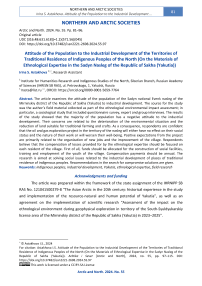Attitude of the Population to the Industrial Development of the Territories of Traditional Residence of Indigenous Peoples of the North (On the Materials of Ethnological Expertise in the Sadyn Nasleg of the Republic of Sakha (Yakutia))
Автор: Astakhova I.S.
Журнал: Arctic and North @arctic-and-north
Рубрика: Northern and arctic societies
Статья в выпуске: 55, 2024 года.
Бесплатный доступ
The article examines the attitude of the population of the Sadyn national Evenk nasleg of the Mirninskiy district of the Republic of Sakha (Yakutia) to industrial development. The source for the study was the author’s field material collected as part of the ethnological environmental impact assessment; in particular, a sociological study that included questionnaire survey, expert and group interviews. The results of the study showed that the majority of the population has a negative attitude to the industrial development. Their concerns are related to the deterioration of the environmental situation and the reduction of land suitable for traditional farming and crafts. As a consequence, respondents are confident that the oil and gas exploration project in the territory of the nasleg will either have no effect on their social status and the nature of their work or will worsen their well-being. Positive expectations from the project are primarily related to the organization of new jobs and the improvement of the village. Respondents believe that the compensation of losses provided for by the ethnological expertise should be focused on each resident of the village. First of all, funds should be allocated for the construction of social facilities, training and employment of the youth of the village. Compensation payments should be annual. The research is aimed at solving social issues related to the industrial development of places of traditional residence of indigenous peoples. Recommendations in the search for compromise solutions are given.
Indigenous peoples, industrial development, Yakutia, ethnological expertise, field research
Короткий адрес: https://sciup.org/148329525
IDR: 148329525 | УДК: [316.48:631.618](=1.2)(571.56)(045) | DOI: 10.37482/issn2221-2698.2024.55.97
Текст научной статьи Attitude of the Population to the Industrial Development of the Territories of Traditional Residence of Indigenous Peoples of the North (On the Materials of Ethnological Expertise in the Sadyn Nasleg of the Republic of Sakha (Yakutia))
DOI:
Currently, a new stage of industrial development of the northern territories of Russia is being observed, new fields are being developed and the exploitation of old fields is being resumed. The state and society face the most urgent task of resolving all the contradictions arising between subsoil users and indigenous peoples. In the Republic of Sakha (Yakutia) (hereinafter referred to as RS(Ya)), the tool for resolving these issues is an ethnological expertise, which, according to Republic’s legislation, is a scientific study of the impact of changes in the ancestral habitat of small-numbered peoples and the socio-cultural situation on the development of ethnic groups 1.
Problems associated with the procedure of conducting and analyzing the results of ethnological expertise are relevant among the scientific community. The research covers most of the territories traditionally inhabited by indigenous peoples. The authors raise both practical and theoretical issues of implementing ethnological expertise, in which the problem of the relationship between mining companies and indigenous peoples is central [1, Poddubikov V.V.; 2, Sadovaya A.N.; 3, Novozhilov A.G.; 4, Golovnev A.V., Komova E.A.; 5, Basov A.S., Kovalsky S.A., pp. 91–92]. For example, it is emphasized that “the extractive industry, as a disproportionately stronger economic structure, destroys the resource and socio-cultural basis of the traditional nature management of northern peoples and displaces them from their ancestral territories” [6, Martynova E.P., Novikova N.I., p. 111]. Moreover, it is argued that total industrial development will lead to the emergence of areas of social and ethno-national tension [7, Golovnev A.V., p. 151]. The widely presented works devoted to the ethnological expertise in RS(Ya) also support the opinion about the presence of pressure of extractive companies on indigenous communities [8, Baisheva S.M.; 9, Pakhomov A.A., Mostakhova T.S.; 10, Basov A.S.; 11, Romanova E.N., Alekseeva E.K.; 12, Sleptsov A.N.; 13, Sosin P.V.; 14, Shadrin V.I.; 15, Astakhova I.S.].
This article presents the author's research on the attitude of the population to new industrial development projects, expectations and fears of the inhabitants on the example of the Sadyn national Evenk nasleg. This nasleg is the only municipal formation within the Mirninskiy district of the Republic of Sakha (Yakutia), included in the List of places of traditional residence and traditional economic activities of the indigenous minorities of the republic. In addition, the entire nasleg is a territory of traditional natural resource management, the area of which is 12,489.3 km2, with only one residential settlement. Materials for the study were collected as part of the ethnological environmental impact assessment (hereinafter referred to as EIA) in 2019 and 2022 for the South-Syuldyukar license area in the village of Syuldyukar. The study methodologies in 2019 and 2022 are identical, and the comparative analysis of the materials showed interesting results.
Materials and methods
In December 2022, a sociological study was conducted in the Sadyn national Evenk nasleg of the Mirninskiy district of the RS(Ya), in which qualitative and quantitative methods were used. The questionnaire survey allowed maintaining anonymity, and this is important given the possible pressure of industrial companies on local communities. The questionnaire is divided into thematic blocks containing various aspects and consists of 75 questions, including questions on the attitude of the local community to the development project, identification of conflicts and points of contact between the indigenous community and the extractive company. Semi-formalized face-to-face and group interviews were conducted on issues of traditional management, the socioeconomic state of the nasleg, the ethno-cultural development of the indigenous peoples of the North. The main topic of the focus groups was the attitude of the population towards the project, as well as the issues of interaction with mining companies and socio-economic development of the nasleg. As it was shown, in rural areas where collective consciousness is developed, the use of this method has proved to be very effective. Thus, two focus groups were organized with conventional names: “Hunter” (residents of the nasleg, engaged in traditional types of economic activities) and “Villager” (residents not engaged in traditional economy). Both groups included respondents of different ages (over 18 years old) and different genders. There were 5 respondents in each group.
The adult population aged 18 years and older took part in the questionnaire survey. To form the sample population, a quota sample was used, compiled on the basis of current lists of village residents as of December 1, 2022, according to which the adult population was 268 people 2. The quota population coincides with the structure of the general population by gender and age. The sample population, when adjusting the sample using the formula for a small population and taking into account the actual sampling error of 5%, amounted to 100 people.
The characteristics of the respondents generally reflect the average image of a nasleg resident. Most of the respondents have been living in the village either since birth or for a very long period. The population is predominantly employed in social institutions, energy and agricultural enterprises (Table 1). Almost the entire adult population, regardless of nationality, is members of indigenous communities. However, the Evenks are the national majority. At the time of the study, the author had data on the ethnic composition only for 2010, when representatives of 5 peoples lived in Syuldyukar village: Yakuts (40.5%), Evenks (55.4%), Evens 3.2%, others 0.9% (Kazakhs, Chuvash). Indigenous small-numbered peoples of the North — Evenks and Evens — made up 58.6% [16, Astakhova I.S., p. 114]. Moreover, according to local residents, Evenks women were sometimes mistakenly registered by civil registry office employees as Evens. This is how the Evens appeared in the village. It should be noted that due to the restoration of nationality, the number of Evenks is regularly increasing.
Table 1
Characteristics of respondents 3
|
Indicators |
% |
|
Gender Male |
50 |
|
Female |
50 |
|
Age 18–34 |
35 |
|
35–49 |
27 |
|
50–64 |
26 |
|
65 and older |
12 |
|
Nationality Evenks |
83 |
|
Yakuts |
16 |
|
other |
1 |
|
Education higher and incomplete higher education |
29 |
|
professional secondary |
33 |
|
elementary vocational |
2 |
|
general secondary |
33 |
|
incomplete secondary |
3 |
|
Main type of activity employee (administration specialist, doctor, teacher, cultural worker, etc.) |
36 |
|
labourer (housing and utilities, etc.) |
20 |
|
working pensioner (employed in the budgetary sphere) |
9 |
|
working pensioner (employed in non-budgetary sphere) |
8 |
|
non-working pensioner |
18 |
|
enterprise manager |
2 |
|
housewife, homemaker (not employed in economic sectors) |
4 |
|
unemployed, registered as unemployed |
1 |
|
other |
2 |
|
Marital status married |
59 |
|
single |
22 |
|
divorced |
5 |
|
widower / widow |
8 |
|
cohabitation (common-law marriage) |
6 |
|
Number of children living in the family did not indicate |
33 |
|
one |
31 |
|
two |
17 |
|
three |
12 |
|
four |
7 |
|
Wealth level not enough money even for food |
7 |
|
there is enough money only for food and basic necessities |
29 |
|
there is enough money to buy consumer goods (clothes and shoes), but not enough to buy durable goods |
36 |
|
I have enough money to buy large household appliances, but not enough to buy a car or a flat. |
26 |
|
I do not experience material difficulties |
2 |
|
Sources of income salary |
75 |
|
pension |
34 |
|
allowances |
9 |
|
other compensation payments |
1 |
|
interest from bank deposits, dividends |
3 |
|
income from entrepreneurial activity |
- |
|
income from private subsidiary farming |
1 |
|
Time of residence in the locality less than 1 year |
5 |
|
1–2 years |
1 |
|
3-5 years |
3 |
|
6–10 years |
3 |
|
11 and longer |
13 |
|
from birth |
75 |
|
Total number of people interviewed |
100 |
Research results
Awareness of the population about the project was 52%, with the most informed men over 50 years of age, most of whom regularly visit the forest area, hunt and collect wild plants (Fig. 1). Some respondents said that they had seen workers in the areas of planned exploration and works had already started. This is confirmed by the analysis of group interview materials, where participants also noted that they had encountered equipment with the name of the company. It should be noted that works are to be started only after the approval of the ethnological expertise.

■ Yes ■ No
Fig. 1. Distribution of respondents’ answers to the question: “Have you heard before about the planned geophysical exploration in the territory of the South-Syuldyukar license area of the Mirninskiy district of the Republic of Sakha (Yakutia) in 2023–2025?” (% of respondents) 4.
Representatives of clan communities and the head of the Sadyn Evenks national nasleg stated that they were not officially informed about the upcoming work and were not familiar with the project; they did not know which specific areas would be affected in the coming season. In general, representatives of the administration and tribal communities served as the main sources of information for the nasleg population about the project (22%). According to focus group participants, a company representative came to the Syuldyukar village in the spring of 2022, and it was reported at a meeting with the population that exploration in the South-Syuldyukar license area will be continued (11%). Analysis of the answer “Other” showed that they were informed about the project from friends or neighbors (6%), or “saw” the work started (2%). The next most popular answer is “Internet”; as young people mainly learnt about the project when communicating in social network chats (6%) (Fig. 2).
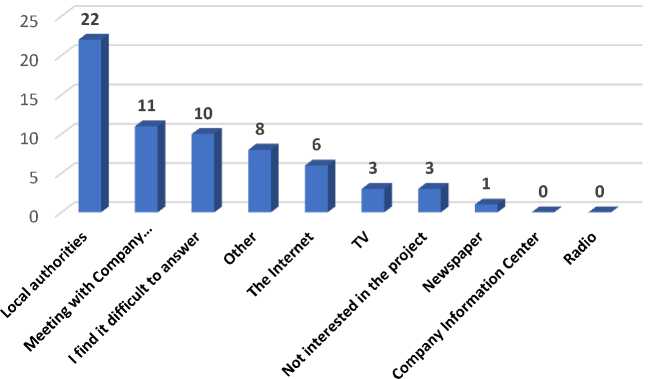
Fig. 2. Distribution of answers to the question: “From what sources did you learn about the project?” (% of respondents) 5.
Analysis of answers to the question “In what form would it be convenient for you to receive information about the project in the future?” showed that the population is still interested in receiving complete and, most importantly, reliable information. Village residents would like to be informed about the project directly from a representative of the Company through the mediation of authorities and public organizations. The most popular answer, regardless of gender and age, was “Meeting with company representatives” (60% of respondents). Despite the pessimistic mood of nasleg residents regarding their future associated with the next round of industrial development, the majority of the population favors an honest and open conversation. 30% of respondents preferred to receive information about the project from local authorities. When analyzing the answers where respondents indicated the media, the distribution is as follows: “Internet” was preferred by 19% of respondents of all age categories except 65 years and older; “television” — 14%, this answer is slightly more common among men, “newspapers” were chosen by 5% of respondents, mostly respondents in the age category of about 50 years and older. 7% of respondents found it difficult to answer, 3% answered “I’m not interested in the project” — these are young men. The answer “other” is 2%; respondents suggest using the village WhatsApp group (Fig. 3). Analysis of data obtained from interviews showed that this messenger is the most popular among the local community; it covers the entire population of the village, regardless of age and gender.
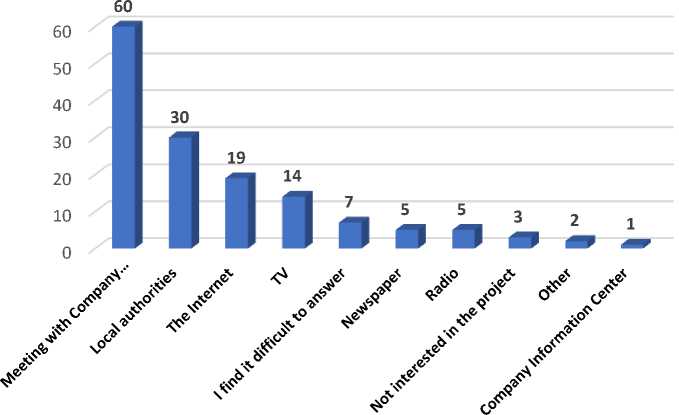
Fig. 3. Distribution of answers to the question: “In what form would it be convenient for you to receive information about the project in the future?” (% of respondents) 6.
The overwhelming majority of the nasleg population, regardless of gender, age and nationality, strongly opposes the project and any interference in nature in general, as this will disrupt their usual way of life. Young people “18–34” are more tolerant: they have a “positive” and “rather positive” attitude towards the project; there are more than 25% of them among this age category. During a comparative analysis of EIA data obtained in 2019, where the research methodology is identical to the present one (N 100), it became noticeable that the situation has slightly changed. Thus, in 2019, the options “negative” and “rather negative” were chosen by 83% of respondents. In 2022, there were only 74% of them. The increase in the number of positively-minded citizens in 2022 can be explained primarily by changes in the socio-economic situation of the region caused by the activities of oil and gas companies (Fig. 4). In particular, in interviews, residents of the village Syuldyukar cited the Botuobuyinskiy nasleg of the same district of the republic as an example, where the local population was able to establish interaction with mining companies: “they were able to defend their right”, “I don’t know how, but they did it”, “we need this too”.
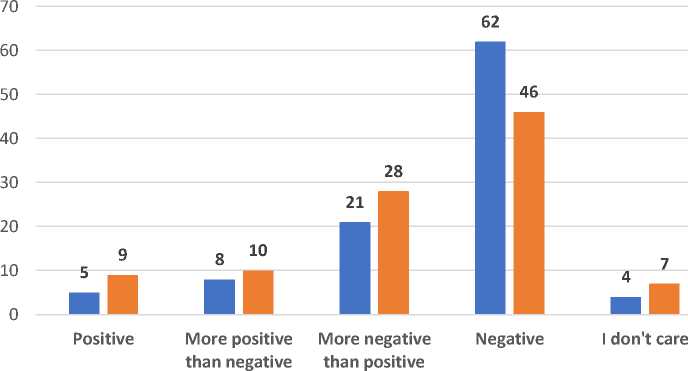
■ 2019 ■ 2022
Fig. 4. Distribution of answers to the question: “How do you feel about this project for geophysical exploration of oil and gas in the nasleg territory?” (2019, 2022) (% of respondents) 7.
The population’s positive expectations from the project are primarily associated with the emergence of new jobs (41%) and improvement of the village (40%). The creation of new jobs remains an urgent problem, since the branch of the state farm “Novyy” of AC Alrosa (PJSC) was liquidated in the village by 2020. Instead of the state farm, a branch of the Yakutsk Cattle state enterprise of the Republic of Sakha (Yakutia) for farming Yakut breed of cows was established. However, the population believes that this enterprise will probably soon meet the fate of the state farm, and therefore, the male population of the village will remain unemployed. At the same time, to the survey question “Would you personally like to take part in this development project?”, only 12% of respondents gave an affirmative answer and 3% found it difficult to answer. These are predominantly men of working age. It is interesting that all of the options presented in the questionnaire about employment were chosen. The most common were: “Labor safety and environmental specialist” and “Mechanic, technician, operator”.
The following popular answers coincide with the answer “improvement of the village”: “investments in schools, kindergartens, rural health care”, “improvement of medical care”, “improvement of transport links in the area”, “prospects for housing construction, renovation of housing stock” (Table 2).
Table 2
Distribution of answers to the question: “What positive results do you expect from this project?” (2019, 2022) (% of respondents)
|
Factor / year |
2019 |
2022 |
|
New workplaces |
54 |
41 |
|
Investments in schools, kindergartens, rural healthcare |
25 |
24 |
|
Village improvement |
43 |
40 |
|
Small business development |
2 |
3 |
|
Student scholarship program |
- |
7 |
|
Improving transport links in the area (increasing the number of flights, road repairs) |
19 |
16 |
|
Improving the quality of mobile communications |
9 |
4 |
|
Improving health care |
6 |
19 |
|
Development of cable TV, Internet |
13 |
5 |
|
Reducing the outflow of young people |
7 |
10 |
|
Prospects for housing construction, renovation of housing stock |
15 |
8 |
|
I don’t expect anything |
27 |
36 |
|
Other |
3 |
6 |
The main problem for residents at present is the construction of a year-round road to the village from Svetlyy settlement. The road passes through the Svetlinskaya hydroelectric power station with a pass entry system, and then crosses a number of streams and small rivers that erode the road, especially in the spring season. Construction of roads and bridges is currently underway. In addition, the construction of a cultural center and reconstruction of the school are planned, but some residents are concerned about the quality of construction: “I wish it would not be like with the gym”, since the gym at the village school collapsed after a couple of years. In focus groups, interviewers said that the village needs social facilities: a kindergarten, a school, a club — they require updating, since they were built during the Soviet period; a coal boiler house — it was “brought to the village in 1990 already used” 8. How could subsoil users help: to participate in the construction of a new sports ground (indoor warm gym) for the entire population of the village, not only for schoolchildren; to help in the reconstruction of the bathhouse.
In 2019, there was public dissatisfaction with the quality of mobile communications and Internet services. In 2022, this issue has been resolved due to the construction and commissioning of fiber-optic communication lines, which ensured constant access to the Internet information and telecommunications network.
Let us note the phenomenon of pessimistic moods in society (both in 2019 and in 2022). This is expressed by a large number of “I don’t expect anything” responses, and the number of such responses is growing (in 2019 — 27%, in 2022 — 36%). Many respondents indicated in the open line “I don’t expect anything good”. In 2022, this attitude is more observed in the age categories “50–64” (46%) and “65 and older” (41%). In the “Hunters” group of interviewees, the
NORTHERN AND ARCTIC SOCIETIES
Irina S. Astakhova. Attitude of the Population to the Industrial Development … phrase “they will destroy us” was even heard. Part of society believes that they are under threat of destruction or being forced out of their places of ancestral residence.
In 2022, public concerns are primarily related to environmental degradation (90%) and declining fish and game stocks (71%). Both men and women of all ages are worried about this. The male population of the village is especially concerned; men are more confident that the implementation of this project will lead to the risk of accidents, reduction of pastures and hunting grounds. A number of respondents associate the increased frequency of fires in the nasleg with the exploration of oil and gas fields, including large fires in 2021. Female respondents in the age category “35–49” more often express concerns related to the deterioration of the health of residents. The increase in the number of newcomers is of greater concern to men of pre-retirement and retirement age. When comparing the data of 2019 and 2022, it can be seen that the concerns of respondents remain the same (Table 3).
Table 3 Distribution of answers to the question: “What are your greatest concerns regarding the development of this project?” (2019, 2022) (% of respondents) 9
|
Factor / year |
2019 |
2022 |
|
Environmental degradation |
88 |
90 |
|
Reduction of fish, commercial animals and game stocks |
64 |
71 |
|
Poaching by employees of industrial enterprises |
15 |
16 |
|
Risk of accidents, emergencies |
21 |
17 |
|
Reduction/withdrawal of pastures, fodder/haylands |
23 |
23 |
|
Reduction/withdrawal of hunting areas |
29 |
31 |
|
Increased crime rate |
- |
1 |
|
Increased level of alcoholism |
- |
1 |
|
Deterioration of public health |
26 |
26 |
|
Increase in prices for food and services |
3 |
5 |
|
Inflow of newcomers |
9 |
12 |
|
No concerns |
2 |
2 |
|
Other |
5 |
2 |
The residents’ concerns are related to the deterioration of the environmental situation and its consequences. The results obtained show how strong the community’s connection to nature is. In the areas of the proposed geophysical exploration, villagers used to collect wild herbs, hunt, and most importantly, some of these areas were hayfields. According to local residents, the forage base in the nasleg is scarce. Tribal communities even considered acquiring deer because they were easier to keep in this ecosystem. However, this area was destroyed by fire in 2021, and reforestation is a long process. Now there is no opportunity to hunt on this territory and “even compensation for these lands will not be given, we will not be allowed to hunt there”, “we believe that it is being deliberately set on fire... such fires have never happened”, “game is leaving due to fires and clearings”. Representatives of the community appealed to the State Assembly of the Republic of Sakha (Yakutia) (Il Tumen) with a request to conduct an investigation, submitted
NORTHERN AND ARCTIC SOCIETIES
Irina S. Astakhova. Attitude of the Population to the Industrial Development … materials, including photos of burnt huts (“seven huts were burnt down”), but there was no response.
The majority of respondents are confident that the oil and gas exploration project in the nasleg territory will not in any way affect their social status and nature of work (everything will remain the same — 45% of respondents) or will worsen their well-being (26%). Only 10% of respondents believe that their well-being will improve, 5% will change their place of residence, 4% hope to get a new job (men “18–34”), 4% found it difficult to answer, 6% chose “other” (“environmental problems will arise”, “this will change our way of life”, “everything will be bad”) (Fig. 5).
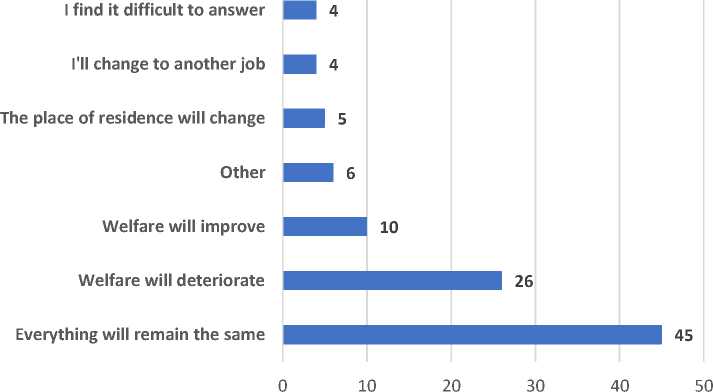
Fig. 5. Distribution of answers to the question: “How will the oil and gas exploration project in the nasleg territory affect your social status and the nature of your work?” (2022) (% of respondents) 10.
To the question “How do you feel about the inflow of population to your nasleg?” the village population predominantly answered that they did not approve of migration — 72%, only 25% approved it, 3% of respondents found it difficult to answer. There are insignificant changes in the answers of respondents of different genders and ages. Men in the age category “18-34” do not approve of the increase in migration flow to nasleg — 28% of surveyed men of this age, and women in the age group “35-49” are more loyal to the arrival of new residents. The majority of those who approve of the arrival of new residents expect the arrival of qualified specialists (42.3%). For example, there is currently a vacancy for a paramedic in nasleg. The prevailing opinion among young people “18–34” is that migration contributes to the rapprochement of peoples. Among those who disapprove, the greatest concern is that migration will cause an overload on the natural environment (about 40%). Regardless of age, male respondents insist that local labor resources should be used (24%) and that the village is unable to provide jobs for all newcomers (32%). Women over 50 years old are wary of an increase in crime in the nasleg with the increase in the number of visitors (more than 50%).
The question: “What methods of compensation for losses from the activities of industrial enterprises to hunters, tribal communities and indigenous people do you consider the most appropriate?” caused a lively discussion among the village residents. The most popular answer is “Construction of structures and facilities that improve the quality of life of the local population”, answered by 59% of respondents; this is the most common answer among men in the age category “50–64”. These are the most active residents of the village; everyone listens to their opinion. 24% of respondents chose financial compensation; this answer prevails among the female audience. The allocation of other territories was chosen by 16% of respondents, and there was no gender factor. The allocation of materials and equipment was also chosen by 16% of respondents, here the highest percentage was observed among men — 24%. 21% of respondents found it difficult to answer, mostly young people “18–34”. “Other” — there were different opinions from “don’t need anything from them” to “it is necessary to conclude an agreement” (Table 4).
Table 4
Distribution of answers to the question: “What methods of compensation for losses from the activities of industrial enterprises to hunters, tribal communities and indigenous people do you consider the most appropriate?” (2022) (% of respondents) 11
|
Construction of structures and facilities that improve the quality of life of the local population |
59 |
|
Money |
24 |
|
Difficult to answer |
21 |
|
Allocation of materials and equipment |
16 |
|
Allocation of other territories |
16 |
|
Other |
5 |
Analysis of group interview materials showed that residents live in one community and “help should be provided to the entire village”. The only precedent for a one-time payment to a tribal community from a mining company (Kuokhaan community received compensation in the amount of 395,466 rubles) is still being discussed in the village, since a significant part of the village residents are members of this tribal community: “they sold their homeland for 300 thousand”, “we feel shame”, “they harmed nature for 1000 years ahead, they left us without berries and game, and they paid us a dab of money”. The money are in the community’s account — “no hand is raised to use it”. Residents propose concluding a tripartite agreement between the tribal community, whose lands are being developed, the municipal organization “Sadyn national Evenks nasleg” and the subsoil user company. The agreement should “specify the construction of social facilities so that benefits for everyone could be seen”, provide jobs for local personnel, train and employ rural youth; compensation payments should be “annual, not one-time, otherwise it’s not fair”. Nasleg residents also ask for advance notification of planned economic works: “we are expecting more than just one person to visit”, “we want them to look at their work”. Residents claimed that they wrote their wishes to the company, but never received a response.
The open question “How do you assess the company’s activities... on the territory of the Sadyn national nasleg?” received 98 responses. The majority of respondents found it difficult to answer, in fact, due to insufficient information about the company (62 people). There were 29 negative answers: from “negative”, “bad”, “they pollute the environment”, “the game is gone” to “they came to us without warning”, “the company is stronger than us”, “they will destroy us”. There were 4 neutral answers “I am not affected”, “the main thing is the development of the village”, “I rather approve... the main thing is that everything should be within the framework of the agreement”. Only three answers were positive.
From the analysis of group interview materials, it can also be found out that nasleg residents study examples of interaction between the indigenous rural population and mining companies. First of all, this is their own experience of interaction with JSC Alrosa: “the Alrosa company signed an agreement for 10 million rubles, they allocate it to nasleg annually for the fact that they got rid of us... they closed a branch of the state farm, we used the entire social package of Alrosa, it’s a shame”. According to respondents, LLC Irkutsk Oil Company carried out land reclamation, in particular, tree planting in the vicinity of the village of Svetlyy. PJSC Surgutneftegas carried out work on land reclamation around the village of Almaznyy. LLC Taas-Yuryakh Neftegazodobycha entered into an agreement with the Botuobuyinskiy nasleg municipal organization and tribal communities: “it improves the village”, “it buys equipment for the community”, and “it employs them”.
Nasleg residents also expect support and help from mining companies that come to work on their lands: “young people are leaving — there is no work, they can give us work, since we can’t hunt”, “they should teach young people to work in industry”, “should develop agriculture”. In addition, respondents expressed doubts about the legality and fairness in relation to themselves: “no one will ask us”, “they will still do what they need”, “how can we demand from private campaigns... notifications, ethnological expertise... we record, signal... we have already learned... but the forestry department and ecologists do not have the equipment to get to the place, they cannot check and record the violation...” Another group of interviewees chose a wait-and-see attitude: “we’ll see”, “we don’t know yet how they will work, while they are only promising to help us, we are watching”. Of course, part of society is more radical: “we will not give up”, “the Motherland is not for sale”, “I don’t want them to work here”.
In each of the two groups, “Hunter” and “Villager”, there are all the presented opinions. We would like to dwell on the differences. Thus, hunters go directly into the forest and see equipment, shift workers, clearings; villagers know about many things only from the words of others, but recently they began to observe equipment on the road to the Svetlyy village, see and hear machinery on the outskirts of the village, helicopters. This worries them. They assume that reconnaissance came close to the village. The population supposes that the village territory is included in the licensed area. The map of the licensed area clearly shows that the fears are not unfounded (Fig. 7).
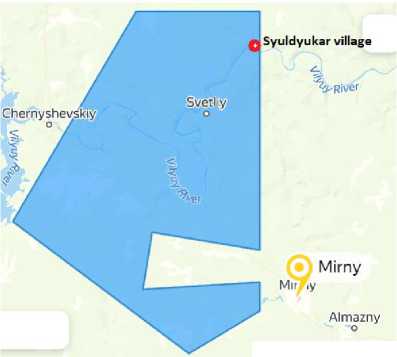
Fig. 7. Map of the South-Syuldyukar subsoil area on the territory of the Mirninskiy district of the RS(Ya) 12
Discussion
Ethnological expertise is considered by researchers primarily as a mechanism of interaction between government authorities, industrial companies, the scientific community and indigenous peoples. During the expertise, information arrays are accumulated, which are analyzed by specialists in various fields of knowledge, and recommendations are given to industrial companies and the indigenous community, which ensures the development of flexible mechanisms adapted to the conditions of the regions [17, Novikova N.I., pp. 131–132]. The key topic is the attitude of the local population to the development project, their fears and expectations.
Researchers pay attention to the fact that industrial companies have an impact on communities, shaping public opinion [18, Vakhtin N.B.]. However, this study showed that industrial companies do not always make contact with the indigenous population, choosing a wait-and-see approach, distancing themselves from the issues raised by the development project.
The legislation on ethnological expertise provides for the calculation of compensation for damage. Some experts note the potential threat of the indigenous people’s interest in receiving damage compensation from corporations rather than long-term sustainable development of the territory of residence [19, Mustafin S.K. et al., p. 11]. Meanwhile, the results of the study demonstrated that the indigenous population insists on the participation of companies in the development of the territory, rather than on one-time compensation. Moreover, compensation in monetary terms causes rejection and a feeling of guilt among the indigenous population.
Scientists from the Yakutsk University, having analyzed investment projects that have undergone ethnological expertise, came to the conclusion that the implementation of large investment projects in the Arctic zone of the Republic of Sakha (Yakutia) for the exploration and extraction of minerals may lead to disruption of the ecosystem, which in turn will lead to the depletion of natural resources for traditional environmental management. As a result, this may cause conflict situations between indigenous peoples and industrial enterprises. At the same time, the authors believe that it is necessary to establish partnerships between all participants of nature use
-
12 LLC “SuldyukarNefteGaz”. URL: https://suldukar.ru/ (accessed 19 October 2023).
NORTHERN AND ARCTIC SOCIETIES
Irina S. Astakhova. Attitude of the Population to the Industrial Development … and economic activities under the control of the state and the active position of the indigenous community [20, Burtseva E.I., Sleptsov A.N., Bysyina A.N., p. 58, pp. 68–69]. However, when the goals of industrial and government entities for the development of the territory largely coincide, the opinion of the indigenous peoples, advocating for the preservation of nature, is practically unheard. It is not easy for the state to act as an independent arbiter when it needs to implement projects.
Conclusion
Thus, the population of the Sadyn national Evenks nasleg municipality, including members of tribal communities, feels that the territory of their traditional livelihood is constantly shrinking. They realize that the lands that were taken away from the Sadyn Evenks for industrial development can no longer be returned, but the process continues. During the Soviet and post-Soviet periods, to some extent, the population of the nasleg was protected by Alrosa, but the liquidation of the state farm branch in the Suldyukar village made the population feel themselves deceived and deprived of their native land. For this reason, the village population had a sharply negative attitude towards the project for oil and gas exploration on nasleg lands. They feel anxiety about the possible critical consequences associated with industrial development: environmental pollution, disruption of the ecological system, depletion of biological resources, and land alienation. At the same time, the population realizes that this process cannot be stopped, and it is necessary to establish a dialogue with mining companies. Residents of Syuldyukar are ready to enter into an agreement with the company, but the municipal organization “Sadyn national Evenks nasleg” should become a party to the agreement, and all residents of the nasleg should receive “compensation” through the construction of social facilities. Tribal communities do not refuse assistance and mutually beneficial cooperation with industrial companies. With the start of this project, residents hope to solve a number of social issues in the village, including the creation of new jobs and improvement of the environment.
One of the directions for further research on this issue could be the development of a methodology for identifying potential social conflicts between the indigenous population and industrial companies, forecasting the development of the conflict situation and its resolution.
Список литературы Attitude of the Population to the Industrial Development of the Territories of Traditional Residence of Indigenous Peoples of the North (On the Materials of Ethnological Expertise in the Sadyn Nasleg of the Republic of Sakha (Yakutia))
- Poddubikov V.V. Rural Groups of Native Small-Numerous Peoples: The Methods of Expert Examina-tion of Traditional Wildlife-Using Systems (On Southern Siberia Data). Tomsk State University Jour-nal, 2012, no. 3 (19), pp. 162–171.
- Sadovoy A.N. Customary Law in Subject Field of Ethnological Examinations. Scientific Dialogue, 2017, no. 11, pp. 410–424. DOI: https://doi.org/10.24224/2227-1295-2017-11-410-424
- Novozhilov A.G. Problems of Formation and Implementation of the Master's Programme ''Ethnolog-ical Examination'' at Saint Petersburg State University. Siberian Historical Research, 2018, no. 1, pp. 90–102. DOI: https://doi.org/10.17223/2312461X/19/7
- Golovnev A.V., Komova E.A. Ethnoexpertise: Taymyr Discourse. Siberian Historical Research, 2022, no. 4, pp. 158–175. DOI: https://doi.org/10.17223/2312461X/38/9
- Basov A.S., Kovalskii S.A. Applying an International Approach for Social Impact Assessment to an Ethnological Expert Review of Western Taymyr Peninsula. Siberian Historical Research, 2021, no. 3, pp. 171–198. DOI: https://doi.org/10.17223/2312461X/33/8
- Martynova E.P., Novikova N.I. Tazovskie nentsy v usloviyakh neftegazovogo osvoeniya: Etnolog-icheskaya ekspertiza 2011 goda: monografiya [Tazov Nenets in the Context of Oil and Gas Devel-opment. Ethnological Examination of 2011]. Moscow, IP A.G. Yakovleva Publ., 2011. 132 p. (In Russ.)
- Golovnev A.V. Ethnological Expertise in the Scenarios of Resource Development on Yamal Peninsu-la. Ural Historical Journal, 2014, no. 2 (43), pp. 143–153.
- Baisheva S.M. The Interaction between Business and Indigenous Peoples of Yakutia: The Social Con-text and the Realities of Life. Business Economics, 2016, vol. 51, iss. 4 (2), pp. 580–586.
- Pakhomov A.A., Mostakhova T.S. The Interaction of the Indigenous Peoples of the North and of the Companies: Problems of Ethnological Expertise in the Republic of Sakha (Yakutia). Vestnik of North-Eastern Federal University. Series: Economics Sociology Culturology, 2017, no. 4 (08), pp. 6–14.
- Basov A.S. Dialogue and Bureaucratic Procedures: "Etnologicheskaya Ekspertiza" (Ethnological Im-pact Assessment) in the Republic of Sakha (Yakutia). Siberian Historical Research, 2018, no. 2, pp. 91–123. DOI: https://doi.org/10.17223/2312461X/20/6
- Romanova E.N., Alekseeva E.K. The Extracting Companies on the Earth of Reindeer Breeders (Eth-noexpertise in the Northwest of Yakutia). Kazan Science, 2015, no. 11, pp. 361–364.
- Sleptsov A.N. The State Ethnologic Examination in the Republic of Sakha (Yakutia). Arctic XXI Centu-ry. Humanitarian Sciences, 2015, no. 1 (4), pp. 15–24.
- Sosin P.V. South Yakutia: Social Adaptation and Ethno-Ecological Problems of the Indigenous Peo-ples of the North. North-Eastern Journal of Humanities, 2015, no. 2 (11), pp. 69–74.
- Shadrin V.I. Etnologicheskaya ekspertiza v Yakutii [Ethnological Expertise in Yakutia]. In: Etnopoliticheskaya situatsiya v Rossii i sopredel'nykh gosudarstvakh v 2013 godu: Ezhegodnyy doklad Seti etnologicheskogo monitoringa i rannego preduprezhdeniya konfliktov [The Ethnopoliti-cal Situation in Russia and Neighboring Countries in 2013: Annual Report of the Network for Ethno-logical Monitoring and Early Warning of Conflicts]. Moscow, IAE RAS Publ., 2014, pp. 331–337. (In Russ.)
- Astakhova I.S. Olekminsk Evenks of Yakutia in Context of Economic Development of the North in 19th21st Centuries. Scientific Dialogue, 2018, no. 9, pp. 221–237. DOI: https://doi.org/10.24224/2227-1295-2018-9-221-237
- Astakhova I.S. Religioznaya situatsiya v evenkiyskikh poseleniya Yakutii (na primere Sadynskogo ev-enkiyskogo natsional'nogo naslega) [Religious Situation in the Evenk Settlements of Yakutia (On the Example of the Sadyn Evenik National Nasleg)]. In: Gumanitarnye nauki v Yakutii: issledovaniya mo-lodykh uchenykh. Vyp. 4: sbornik nauchnykh statey [Humanities in Yakutia: Research of Young Scien-tists. Iss. 4: Collection of Scientific Articles]. Yakutsk, Institute of Humanities Research and Problems of Small Peoples of the North Siberian Branch of the Russian Academy of Sciences Publ., 2020, pp. 112–118. DOI: https://doi.org/10.25693/gumnauki/2020/4 (In Russ.)
- Novikova N.I. Anthropological Expert Review: Academic Discourse and Indigenous People's Expecta-tions. Arctic: Ecology and Economy, 2018, no. 1 (29), pp. 125–135. DOI: https://doi.org/10.25283/2223-4594-2018-1-125-135
- Vakhtin N.B. Ethnological Expert Assessment: Ethnic Groups or People? Ethnographic Review, 2019, no. 4, pp. 135–139. DOI: https://doi.org/10.31857/S086954150006197-6
- Mustafin S.K., Trifonov A.N., Milinchich M.A., Struchkov K.K. Environmental Audit and Ethnological Expertise of Environmental Risks of Subsoil Use in the Circumpolar Zone. In: Arctic Development: Humanitarian Dimension: Proc. All-Russ. Sci. Conf. 15 February 2023. Saint Petersburg, Pushkin Len-ingrad State University Publ., 2023, pp. 6–12.
- Burtseva E.I., Sleptsov A.N., Bysyina A.N. Industrial Development of the Territories of the Arctic Zone of Yakutia and Ethnological Expertise of Investment Projects. Arktika i Sever [Arctic and North], 2023, no. 51, pp. 52–72. DOI: 10.37482/issn2221-2698.2023.51.52

